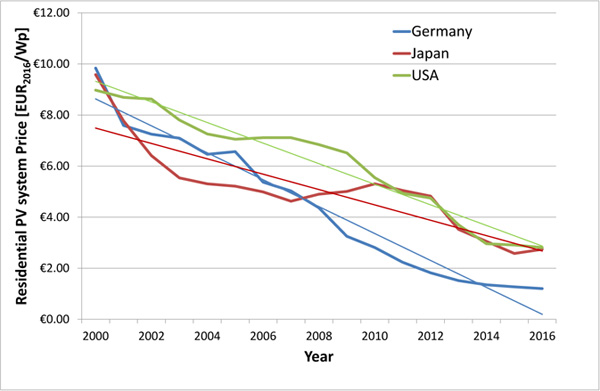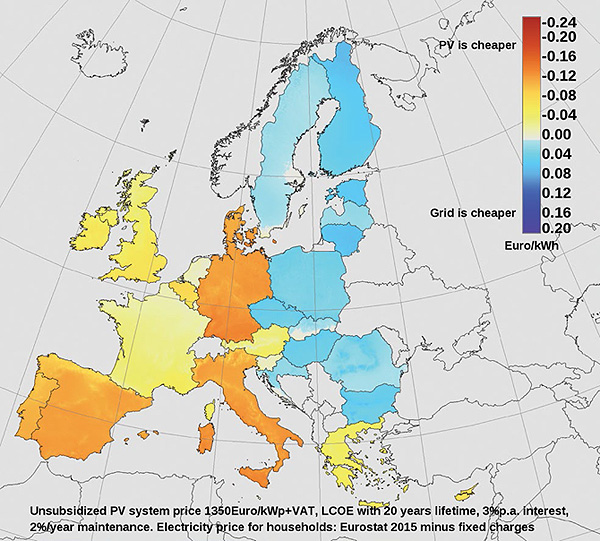 Over the last decade, prices for residential grid-connected PV systems have decreased significantly, as shown in Fig.1. The increase in PV system prices in Japan, between 2007 and 2010 as well as the increase from 2015 to 2016, are due to changes in exchange rates; in the local currency the prices fell further.
Over the last decade, prices for residential grid-connected PV systems have decreased significantly, as shown in Fig.1. The increase in PV system prices in Japan, between 2007 and 2010 as well as the increase from 2015 to 2016, are due to changes in exchange rates; in the local currency the prices fell further.

Figure 1: Residential PV system price development over the last decade (data sources: IEA PVPS, BSW, DoE SunShot Initiative, Eurostat, OECD key economic data)
In September 2016, the worldwide average price of a residential system without tax was given as USD 1.67/Wp (EUR 1.49/Wp) about 25% higher than in Europe with EUR 1.21/Wp or Australia1. Taking the European price and adding a surcharge of EUR 0.14/Wp for fees, permits, insurance, etc., an installed PV system costs EUR 1 350/kWp without financing2 and VAT. The influence of the European VAT rates on investment costs and LCOE are shown in the European Cost Maps3.
As shown in a growing number of countries, electricity production from residential PV solar systems can be cheaper than the variable part of residential electricity prices, depending on the actual electricity price and the local solar radiation level. Therefore, using self-generated electricity provides a means to lower the electricity bill on one hand, and to avoid excessive penetration of PV generated electricity in the grid network. In the case of a PV system size that generates as much electricity as the customer uses over a year, the actual consumption during the time of generation is in general about 25% - 30% on residences, in commercial buildings it can be more4, 5.
There are in principle two methods, to increase the direct consumption ("Self-Consumption") of solar electricity. One is to use intelligent control systems, which switch major loads (washing/dryer machines, heat pumps, refrigerators, air-conditioners) on when the sun is shining. The second one requires a means to store the energy, either as electricity which requires accumulators, or as "product", (heatstorage, cold-storage or pumped water), for use at night or rainy days. Storing electricity has the additional advantage of making energy offers to the network operator at times the operators chooses as being profitable.
Nevertheless, some fraction of the electricity generated has to be sold to the grid. The question is what kind of pricing should be used – contract, wholesale or day-ahead prices. The fact that the costs of PV-generated electricity can be equal to or lower than residential electricity costs is not yet sufficient to support a self-sustained and unsupported market.
For the benchmark calculation of residential systems operation, maintenance and repair (O&M) costs of 2% was used, which is higher than in other analyses. This reflects the fact that labour costs related to O&M activities have not decreased like the hardware components. Depending on the actual radiation level, the 2% O&M costs are the second or third largest cost factor. The O&M costs cover the foreseeable repairs and exchange costs of components like the inverter, as well as the annual degradation of the solar modules as specified by the manufacturers.
Depending on the actual radiation level, the 2% O&M costs are a main cost factor besides financing costs. The O&M costs cover the foreseeable repairs and exchange costs of components like the inverter, as well as the annual degradation of the solar modules as specified by the manufacturers. Adding a conservative safety margin of 0.8 EUR cent/kWh on top of the 2.7 EUR cent /kWh results in an electricity price of 2.9 to 3.5 EUR cent/kWh after the 20-year financial payback period, depending on the actual solar radiation.
The average European residential electricity price given by Eurostat6 for the second semester of 2015 was EUR 0.211/kWh, including fixed charges. Fixed charges vary widely between EUR 20 and 170 per year, depending on the respective Member State and electricity provider. The same holds true for the variable part of the electricity price, which can vary between EUR 0.075 and 0.26 per kWh. Nevertheless, PV-generated electricity for the lower ROI financing options, which are more realistic for private consumers, is already cheaper for a large number of European Union citizens. Cyprus, Denmark and Germany had the highest prices with EUR 0.294/kWh, EUR 0.292/kWh and EUR 0.248/kWh, respectively.

Table 1: LCOE of PV-generated electricity for residential systems with a system price of EUR 1350/kWp (excluding VAT, because the differences in the various countries are too large), 2% O&M cost, an annual generation of 1000 kWh/kWp/year and financial lifetimes of 20 years

Table 2: LCOE of PV-generated electricity for residential systems with a system price of EUR 1350 kWp (excluding VAT, because the differences in the various countries are too large), 2% O&M costs, an annual generation of 1300 kWh/kWp/year and a financial lifetime of 20 years
The profitability of an unsubsidised solar PV system depends primarily on the owner's self-consumption, as less energy has to be purchased from the utility. In the case of a PV system size that generates as much electricity as the customer uses over a year, the actual consumption during the time of generation is in general only around 30% if no demand shifting or local storage is applied. Therefore, 70% of the generated electricity has to be sold to the grid. The question is what kind of pricing should be used – contract, wholesale or day-ahead prices.

Figure 2: Comparison of European residential electricity prices with electricity generated by a PV solar system
The first option for improving profitability is to increase self consumption by demand shifting and using electrical appliances like the washing machine, dishwasher, electric hot water haters or heat pumps during the day when the sun shines. Another option is to use the difference between the PV electricity generation costs and the household retail price to invest in local storage options, be they residential or community-owned. The current investment costs for a residential battery storage system are roughly equally divided between the batteries and the electronic control components. In the future, it is very likely that the solar inverter will include large parts of the necessary electronics, thereby lowering the costs significantly.
As an indication of storage costs, according to BNEF prices for battery packs for electric vehicles have declined from about USD 1000/kWh in 2010 to USD 350/kWh in H2 2015 and could reach USD 200/kWh by 20207. Lithium-ion batteries have an average of 5000 cycles, and with the above cost estimates, this would corresponds to net kWh costs component for the full used battery pack of USD 0.07/ kWh (EUR 0.063/kWh) and should fall to USD 0.04/kWh (EUR 0.036/kWh) by 2020. However, these costs do not yet include the investment for the power and control electronics needed to combine it with a PV system.
However, LCOE of residential battery storage systems do not only depend on the CAPEX (battery pack, power and control electronics and installation) and total storage cycles, but are strongly influenced by the sizing of the PV and battery systems and the actual use of the battery system, i.e. depth of discharge, overall battery system efficiency, usable annual storage cycles and actual kWh stored and used8. Therefore, there is a wide range of prices of electricity from storage at EUR 0.18 to 0.36/kWh, which has to be added to the PV LCOE.
Some electricity providers in Europe are already offering PV systems and local storage to their customers, often including maintenance services. The packages also include apps to monitor the performance of the system, use of electricity and often functionality to control the match between demand and supply. The motivation for this model is described by those companies as follows: "This gives customers a complete and compatible package consisting of a PV system, storage device, app, and green electricity tariff."
Battery producers and storage system developers have started to offer their customers the organisation of their decentralised electricity generation and storage facilities as virtual power plants and acting as electricity providers and traders. Examples are Sonnen Gmbh or E3/DC.
In Germany KfW is offering loans with a non-repayable component for PV systems including storage with a maximum system power of 30 kWp [KfW 2016]. The loan is only available if the maximum injected power is 50% or less of the nominal power rating of the PV system. The maximum eligible amount is 25% of EUR 2.000 per kWp if the PV system and the battery storage are installed at the same time and EUR 2.200 per kWp of the PV system if the system was installed after 31 December 2012 and more than 6 months have passed before the battery storage is added. However, the maximum eligible amount is reduced by 3% each 6 months starting 1 July 2016. The available funds for 2016 were already allocated at the beginning of October 2016 and new applications are now only accepted from 1 January 2017 on. The programme will be terminated at the end of 2018.
Another concept is "virtual storage" for electricity generated by PV systems either for a monthly fee or a down payment for a number of years. To take advantage of this offer, the PV system owner has to be a customer of the respective service provider. The advantage of the virtual storage is that the customer has no installation and maintenance costs for the storage system and virtually infinite lifetime.
In addition there are a number of companies, which offer the management of swarm or cluster storage facilities in cooperation with DNO’s. However, detailed business information are very limited at the moment.
According to various consultancy reports, the electricity battery storage market is expected to grow 10-fold over the next five years and exceed EUR 6 billion by 2022. This market development, together with a further retail price increase and a PV system price reduction, could lower the LCOE of a PV system, including storage, below average European electricity retail prices and make PV electricity the lowest cost option for more than half of the Europeans within the next five years
Biography:
Dr. Arnulf Jäger–Waldau is a Scientific Officer and Senior Scientist at the Renewables and Energy Efficiency Unit, Institute for Energy and Transport of the European Commission’s Joint Research Centre since 2001. He works on the assessment of renewable energy technologies, the effectiveness of their implementation, their integration into energy infrastructures and the role of renewable energy for climate change mitigation.
Since 1987 he works in the field of material research for solar cells and holds patents on semiconductor material deposition for thin film solar cells and solar module design.
He has more than 200 publications in peer reviewed journals and conference proceedings ranging from materials research for PV and solar cell development to market studies and policy evaluations for Renewable Energies. He is the author of the European Commission's annual "Photovoltaic Status Report", which is published annually since 2002.
From 2011 to 2014 he was the Technical Chairman of the European Photovoltaic Solar Energy Conference (EUPVSEC) and served as European Co-Chair of the 6th World Conference on Photovoltaic Power Conversion in Kyoto, November 2014 as well as Conference Chairperson of the E-MRS Spring Meeting in 2009 and 2013.
Dr. Jäger-Waldau was a Lead Author for Solar Energy of the Special Report of the IPCC on Renewable Energy and Climate Change Mitigation. He served as a reviewer of the Global Energy Assessment Report (GEA) published in 2012 and as a reviewer of the 5th Assessment Report (AR5) of IPCC published 2014.
He serves as a member of the Academic Advisory Board of the Chinese Trina State Key Laboratory for Photovoltaics, Academic Committee Vice Chairman member of the Asian Photovoltaic Industry Association (APVIA), member of the International Advisory Board of the Warsaw University Photovoltaic Centre and member of the Scientific Advisory Board of the Solar Research Centre of the Bulgarian Academy of Science. From 2005 to 2013 he was a member of the Executive Committee of the European Materials Research society (E-MRS).
Contact details: arnulf.jaeger-waldau@ec.europa.eu
1) PVinsights, September 2016, http://pvinsights.com/SolarSystem/SolarSystemPrice.php Solar Choice, PV Price Index, http://www.solarchoice.net.au
2) A. Jäger Waldau, PV Status Report 2016
3) T. Huld, A. Jäger Waldau, H. Ossenbrink, S. Szabo, E. Dunlop, N. Taylor, Cost Maps for Unsubsidised Photovoltaic Electricity, JRC 91937
4) Self-Consumption of Electricty by Households, Effects of PV System Size and Battery Storage, Thomas Huld, Holger Ruf, Gerd Heilscher, Proceedings of the 29th EUPVSC, Amsterdam 2014
5) Janina Moshövel, Kai-Philipp Kairies, Dirk Magnor, Matthias Leuthold ,Mark Bost, Swantje Gährs Eva Szczechowicz, Moritz Cramer, Dirk Uwe Sauer,,Analysis of the maximal possible grid relief from PV peak power impacts by using storage systems for increased self-consumption, Applied Energy, Volume 137, 1 January 2015, Pages 567–575
6) EUROSTAT, Electricity price statistics, May 2016; http://ec.europa.eu/eurostat/statistics-explained/images/f/f2/Half-yearly_electricity_prices_%28EUR%29_V2.png
7) Bloomberg New Energy Finance, 01 December 2015, H2 2015 Electric Vehicle Battery Price Survey
8) Franz Baumgartner, presentation at University Erlangen i-MEE, Germany, 11 May 2012
Franz Baumgartner, presentation EUPVSEC 32, Munich, Germany, 22 June 2016